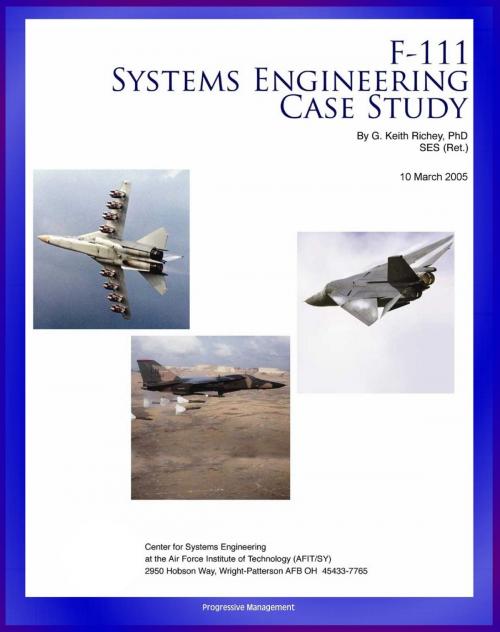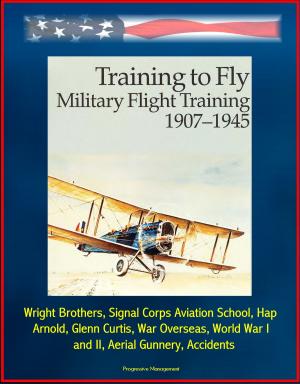F-111 Systems Engineering Case Study: Technical Details, Program History, Combat Operational History of Controversial Fighter-Attack Aircraft
Nonfiction, Science & Nature, Technology, Aeronautics & Astronautics, History, Military, Aviation| Author: | Progressive Management | ISBN: | 9781476202730 |
| Publisher: | Progressive Management | Publication: | July 20, 2012 |
| Imprint: | Smashwords Edition | Language: | English |
| Author: | Progressive Management |
| ISBN: | 9781476202730 |
| Publisher: | Progressive Management |
| Publication: | July 20, 2012 |
| Imprint: | Smashwords Edition |
| Language: | English |
This is one of a series of systems engineering case studies prepared by the Air Force Center for Systems Engineering. This case study analyzes the General Dynamics (GD) F-111, unarguably the most controversial fighter-attack aircraft ever developed. It suffered from a nearly impossible multi-role/multi-service requirement specification, and a protracted development cycle in which numerous serious technical problems had to be identified and corrected. Of the 1,726 total aircraft buy that had originally been planned in 1962, only 562 production models of seven different variants were completed when production ended in 1976.
The systems engineering process and its application to the F-111 program from 1958 to 1976 will be examined through discussion of five fundamental systems engineering learning principles that were derived from research on the F-111 program and from interviews with key F-111 government and contractor managers. Through examination of these systems engineering learning principles, the reader will gain an appreciation of the circumstances in the F-111 program that had the most influence on the outcome of the program and the government and contractor personnel who managed the F-111 systems development.
The study provides a wealth of technical information about the aircraft and its complex history.
The Department of Defense is exponentially increasing the acquisition of joint complex systems that deliver needed capabilities demanded by our warfighter. Systems engineering is the technical and technical management process that focuses explicitly on delivering and sustaining robust, high-quality, affordable solutions. The Air Force leadership has collectively stated the need to mature a sound systems engineering process throughout the Air Force. Gaining an understanding of the past and distilling learning principles that are then shared with others through our formal education and practitioner support are critical to achieving continuous improvement.
These cases support academic instruction on SE within military service academies, civilian and military graduate schools, industry continuing education programs, and those practicing SE in the field. Each of the case studies is comprised of elements of success as well as examples of SE decisions that, in hindsight, were not optimal. Both types of examples are useful for learning. Along with discovering historical facts, we have conducted key interviews with program managers and chief engineers, both within the government and those working for the various prime and subcontractors. From this information, we have concluded that the discipline needed to implement SE and the political and acquisition environment surrounding programs continue to challenge our ability to provide balanced technical solutions.
FOREWORD * ACKNOWLEDGEMENTS * EXECUTIVE SUMMARY * 1.0 SYSTEMS ENGINEERING PRINCIPLES * 1.1 General Systems Engineering Process * 1.2 F-111 Major Learning Principles * 2.0 F-111 SYSTEM DESCRIPTION * 2.1 F-111 Characteristics * 3.0 F-111 SYSTEMS ENGINEERING PRINCIPLES * 3.1 Learning Principle 1 - Requirements Definition and Management * 3.2 Learning Principle 2 - Systems Architecture and Design Trade-Offs * 3.3 Learning Principle 3 - Communications and Systems Management * 3.4 Learning Principle 4 - Validation and Verification * 3.5 Learning Principle 5 - Program Management * 4.0 SUMMARY * 5.0 REFERENCES * 6.0 LIST OF APPENDICES * Appendix 1 - Completed Friedman Sage Matrix for F-111 * Appendix 2 - Biography * Appendix 3 - F-111 History and Variants * Appendix 4 - Program Milestone Charts * Appendix 5 - Combat Operations * Appendix 6 - Transonic Drag * Appendix 7 - F-111 Inlet-Engine Compatibility Problem * Appendix 8 - Wing Carry Through Box Failure and Impact on Subsequent Aircraft Development
This is one of a series of systems engineering case studies prepared by the Air Force Center for Systems Engineering. This case study analyzes the General Dynamics (GD) F-111, unarguably the most controversial fighter-attack aircraft ever developed. It suffered from a nearly impossible multi-role/multi-service requirement specification, and a protracted development cycle in which numerous serious technical problems had to be identified and corrected. Of the 1,726 total aircraft buy that had originally been planned in 1962, only 562 production models of seven different variants were completed when production ended in 1976.
The systems engineering process and its application to the F-111 program from 1958 to 1976 will be examined through discussion of five fundamental systems engineering learning principles that were derived from research on the F-111 program and from interviews with key F-111 government and contractor managers. Through examination of these systems engineering learning principles, the reader will gain an appreciation of the circumstances in the F-111 program that had the most influence on the outcome of the program and the government and contractor personnel who managed the F-111 systems development.
The study provides a wealth of technical information about the aircraft and its complex history.
The Department of Defense is exponentially increasing the acquisition of joint complex systems that deliver needed capabilities demanded by our warfighter. Systems engineering is the technical and technical management process that focuses explicitly on delivering and sustaining robust, high-quality, affordable solutions. The Air Force leadership has collectively stated the need to mature a sound systems engineering process throughout the Air Force. Gaining an understanding of the past and distilling learning principles that are then shared with others through our formal education and practitioner support are critical to achieving continuous improvement.
These cases support academic instruction on SE within military service academies, civilian and military graduate schools, industry continuing education programs, and those practicing SE in the field. Each of the case studies is comprised of elements of success as well as examples of SE decisions that, in hindsight, were not optimal. Both types of examples are useful for learning. Along with discovering historical facts, we have conducted key interviews with program managers and chief engineers, both within the government and those working for the various prime and subcontractors. From this information, we have concluded that the discipline needed to implement SE and the political and acquisition environment surrounding programs continue to challenge our ability to provide balanced technical solutions.
FOREWORD * ACKNOWLEDGEMENTS * EXECUTIVE SUMMARY * 1.0 SYSTEMS ENGINEERING PRINCIPLES * 1.1 General Systems Engineering Process * 1.2 F-111 Major Learning Principles * 2.0 F-111 SYSTEM DESCRIPTION * 2.1 F-111 Characteristics * 3.0 F-111 SYSTEMS ENGINEERING PRINCIPLES * 3.1 Learning Principle 1 - Requirements Definition and Management * 3.2 Learning Principle 2 - Systems Architecture and Design Trade-Offs * 3.3 Learning Principle 3 - Communications and Systems Management * 3.4 Learning Principle 4 - Validation and Verification * 3.5 Learning Principle 5 - Program Management * 4.0 SUMMARY * 5.0 REFERENCES * 6.0 LIST OF APPENDICES * Appendix 1 - Completed Friedman Sage Matrix for F-111 * Appendix 2 - Biography * Appendix 3 - F-111 History and Variants * Appendix 4 - Program Milestone Charts * Appendix 5 - Combat Operations * Appendix 6 - Transonic Drag * Appendix 7 - F-111 Inlet-Engine Compatibility Problem * Appendix 8 - Wing Carry Through Box Failure and Impact on Subsequent Aircraft Development















